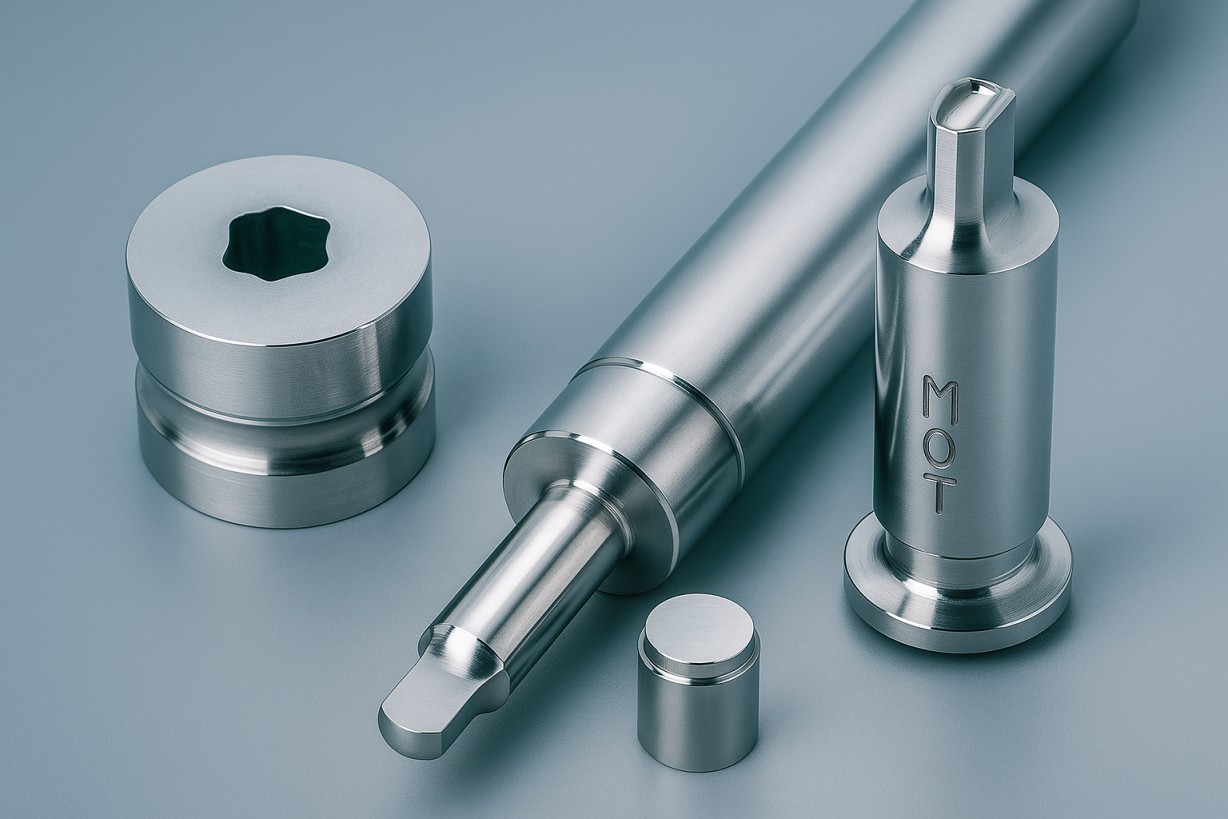Tablet punch face design represents one of the most critical decisions in pharmaceutical tablet development and manufacturing. The shape of the punch tip, often called the cup profile, directly determines the tablet’s face geometry and influences far more than just appearance. These geometric differences affect mechanical strength, dissolution characteristics, defect propensity, and even the quality of embossed logos or break-lines.
Selecting the appropriate punch type requires careful balancing of formulation needs, production constraints, and end-use requirements. This comprehensive guide provides technical insights into common tablet punch face types, their impacts on tablet characteristics, engineering considerations, and selection criteria for different pharmaceutical applications.
Overview of Tablet Punch Face Types
Flat-Faced Punches
Flat-Faced Bevel-Edged (FFBE): The punch tip is essentially flat with a slight beveled edge or chamfer around the tablet’s perimeter to prevent sharp corners. This design maximizes the tablet’s face area, making it ideal for large logos or expansive tablets, while creating a wide, angular sidewall.
Flat-Faced Radius-Edge (FFRE): A newer variant that replaces the straight bevel with a smooth radius curve at the edge. This design offers improved punch durability and reduces the risk of edge chipping compared to traditional beveled designs.
Concave Punches
Shallow Concave: Features a gently curved cup profile with minimal curvature relative to diameter. Tablets appear only slightly convex, often almost flat-looking for larger diameters. This profile provides edge rounding for easier swallowing while maintaining a large face area. It’s particularly suitable for large diameter tablets requiring high compression force, as the shallow cup maintains punch tip strength.
Standard Concave: The most widely used profile for oral tablets, offering moderate cup depth that produces clearly convex tablet faces without being extreme. This single-radius design balances good swallowability with sufficient punch tip thickness for durability. Standard concave tablets typically have smaller face diameters than equivalent flat tablets since material is distributed into the cup’s depth.
Deep Concave: Features pronounced concave cupping with larger curvature, yielding highly convex, lens-shaped tablets. While sometimes chosen for smaller tablets or aesthetic reasons, the steep curvature creates tablets with much thinner centers than edges, reducing face area and creating more rounded shapes.
Extra-Deep Concave/Ball Punch: Extremely deep cupping produces very domed, almost spherical tablets reminiscent of traditional “pill” shapes. These punches are less common today due to manufacturing challenges and structural limitations.
Edge Modifications
Regardless of face profile, punches often incorporate edge modifications. Beveled edges feature chamfered tablet perimeters, while radius edges provide smooth curves. These modifications affect both tablet aesthetics and tool durability, with radius edges typically strengthening both punch and tablet edge by softening sharp corners.
Impact of Cup Depth on Tooling Strength
Cup depth has profound structural implications for punch durability and compression capabilities. Shallow or flat cups maintain more steel at the punch tip’s perimeter, allowing higher compression pressures. Deeper cups result in thinner punch tip cross-sections, particularly at edges, limiting maximum compression force before risking tip fracture.
For example, a small punch producing ball-shaped tablets can only compress at very low forces, while the same size punch with shallow cupping could safely handle compression forces an order of magnitude higher. This relationship means high-dose or large tablets typically require flatter profiles to avoid overstressing punches.
Impact of Punch Type on Tablet Characteristics
Mechanical Strength and Hardness
Punch face profile significantly influences tablet mechanical properties. Flat-faced or shallow concave punches generally produce mechanically stronger tablets than deep concave designs. Research shows biconvex tablets exhibit 1-17% higher elastic recovery after compression and are typically 0.01-0.15 MPa weaker in crushing strength compared to flat-faced tablets of identical formulation.
Deep concave shapes create non-uniform density distribution, with tablet centers potentially less dense than edges due to differential compression. This can result in tablets strong at the rim but weaker at the core. The center of deeply biconvex tablets often represents the weakest point, contributing to why extremely concave “ball” pills have largely fallen from favor.
Flat-faced radius edge (FFRE) designs can maximize tablet solidity through uniform compression across the entire cross-section. For formulations with marginal tablet strength, choosing flatter punch faces typically yields harder tablets than deeply convex shapes under identical compression forces.
Dissolution and Disintegration
While formulation factors often dominate dissolution behavior, tablet geometry matters in certain cases. Flat tablets offer larger face surface areas in contact with dissolution media, whereas biconvex tablets concentrate more material in the thicker “belly” with slightly less initial surface exposure.
For conventional immediate-release tablets, these surface area differences typically produce only subtle dissolution variations. However, specialized applications show clearer punch type effects. In Multi-Unit Pellet System (MUPS) tablets containing coated pellets, research demonstrates that deep concave punches result in less coating damage and consequently slower drug release compared to flatter punches. The high concavity “cushions” pellets by redirecting compression stress into powder bed rearrangement.
Capping and Lamination Risk
Capping (tablet layer splitting) and lamination (internal layer separation) represent serious tablet defects closely tied to punch selection. These problems occur when compression-induced internal stresses release too rapidly or unevenly, causing horizontal plane cracking.
Biconvex tablets are documented as more prone to capping than flat tablets in many cases. The convex shape introduces higher stress gradients where tablet centers and edges compact differently, and elastic rebound upon ejection can cause splitting. Recent research quantitatively confirmed that increasing cup depth correlates with higher capping propensity through a defined “Capping Index” that worsens from flat-face to shallow concave to deep concave punches.
Finite element analysis reveals that deeper concave profiles create greater tablet anisotropy (axial versus radial pressure differences), directly contributing to capping. For formulations with capping tendencies, selecting flatter punch profiles represents one of the simplest mitigations.
Deep concave or ball punches are particularly notorious for capping issues due to air trapping. Highly convex punches can trap air in the die center during compression, which expands and causes lamination. This problem is less common with flat punches since powder beds are thinner and air escapes more readily.
Branding, Engraving and Appearance
Tablet face design often responds to branding requirements for logos, product names, or score lines. Flat-faced tablets offer maximum printable or engravable area, utilizing the entire face for branding elements. Shallow concave tablets also provide relatively large, even canvases for engraving.
As cup depth increases, usable embossing area shrinks. Very convex tablet centers curve away, requiring smaller characters that distort toward edges. Industry guidance recommends avoiding very deep cups like ball shapes for heavy embossing or large logos, as curvature reduces effective area and distorts imprints.
Deep concave tablets’ softer cores can be problematic for engraving quality. Embossing creates stress concentrators, and weak tablet cores may result in flaking or chipping during ejection. For intricate logos, flatter tablet faces maintain strength behind engraved elements and reduce sticking/picking problems.
Engineering Factors in Punch Selection
Fill Volume and Tablet Size
Required tablet mass and density partially dictate optimal shapes. Deeper cups mean punch tips intrude more into dies at full compression, effectively reducing achievable tablet thickness for given fills. High-dose drugs, vitamins, or effervescents benefit from flat or shallow cups allowing thicker tablets without excessive diameter expansion.
Pressure Distribution and Dwell Time
Different punch shapes compress powder beds differently. Flat punches contact powder across entire tablet surfaces simultaneously at peak compression, while curved punches contact gradually. This affects dwell time under pressure and can influence lateral powder flow, with highly curved punches potentially elevating die-wall pressures and making ejection more difficult.
Tooling Strength and Wear
Deep cups reduce punch tip mechanical strength and accelerate wear with abrasive formulations. Particles slip and grind along steep curvatures during compression, particularly affecting nutraceutical or mineral tablets. Deep concave punches experience more aggressive lateral particle movement, causing surface erosion and potential engraving distortion.
Flatter punches provide more direct compression with less lateral movement, reducing abrasive wear. Sharp edge angles may cause chipping under high pressure, making radius edges or slight bevels advantageous for extending tool life.
Cleaning and Maintenance
Intricate punch faces present greater cleaning and maintenance challenges. Flat punches allow straightforward cleaning, while concave punches (especially deep ones with engraving) have recessed surfaces where powder can impact. Improper cleaning can lead to corrosion or sticking problems.
Deep cups require specialized tools like shaped nylon brushes and often benefit from ultrasonic cleaning. Maintenance includes monitoring cup depth wear over time, as punches gradually change shape with use, affecting tablet consistency.
Selection Criteria Based on Application
High-Dose & Large-Format Tablets
Vitamins, effervescents, and chewables requiring large powder amounts favor flat-faced or very shallow concave punches. Effervescent tablets are almost always flat-faced with slight bevels, maximizing fill volume while creating broad dissolution surfaces.
Formulations Prone to Capping
Materials with capping tendencies benefit from flatter punch designs. High crystalline drug content or poorly compactible actives often perform better with flat or shallow convex shapes due to reduced anisotropy.
Abrasive or Granular Formulations
Nutraceuticals and mineral tablets containing hard or large granules increase tool wear and sticking risk. Simpler, flatter punch profiles extend tool life by reducing lateral abrasion and particle wedging.
Tablets for Coating
Film-coated tablets typically perform best with moderate cup depths (shallow or standard concave). This profile rolls well in coating pans without sharp edges while maintaining adequate surface area for coating adhesion.
Fast-Dissolve or Chewable Tablets
Orally disintegrating tablets (ODTs) and chewables often use flat-faced or slightly convex shapes to maintain appropriate hardness for quick disintegration while providing comfortable mouthfeel.
Punch Type Comparison Summary
| Punch Type | Best Applications | Key Advantages | Main Challenges |
|---|---|---|---|
| Flat-Faced (Bevel-Edge) | Large-dose tablets, effervescents, major logos | Maximum face area, highest volume capacity, uniform density | Sharp edges without proper beveling, thick appearance |
| Flat-Faced (Radius-Edge) | Hard tablets, abrasive formulations | Improved durability, reduced chipping risk | Slightly less face area than beveled |
| Shallow Concave | Standard tablets, coated products | Strong tablets, high compression capability, gentle rounding | Potential coating edge issues if not radiused |
| Standard Concave | Most oral tablets, balanced requirements | Good robustness, swallowability, pill-like appearance | Some capping increase, center softness |
| Deep Concave | Small tablets, aesthetic differentiation | Very smooth for swallowing, distinctive appearance | High capping risk, softer cores, limited embossing area |
| Extra-Deep/Ball | Specialized small tablets | Easy swallowing when small | Highest capping propensity, fragile punches, no embossing area |
Conclusion
Selecting the optimal punch face type requires balancing multiple factors including formulation characteristics, production requirements, and end-use needs. Flat or shallow concave punches generally provide the best combination of strength and reliability for large, high-dose, or challenging formulations. Standard concave designs offer excellent compromise solutions for conventional tablets, while deep concave and specialty shapes should be reserved for applications that truly warrant their unique benefits.
Success depends on understanding the trade-offs between tablet appearance, manufacturing performance, and quality consistency. Collaboration with tooling suppliers and tablet design specialists becomes essential when venturing beyond standard shapes, as they can suggest modifications like lands, radii, or specialized coatings to achieve desired tablet characteristics without sacrificing manufacturability.
The ultimate goal remains producing tablets that meet end-user expectations while running smoothly in production with high quality yields. By applying these selection principles regarding punch geometry impacts, engineering constraints, and application-specific criteria, pharmaceutical manufacturers can make informed decisions that optimize both product performance and manufacturing efficiency.

